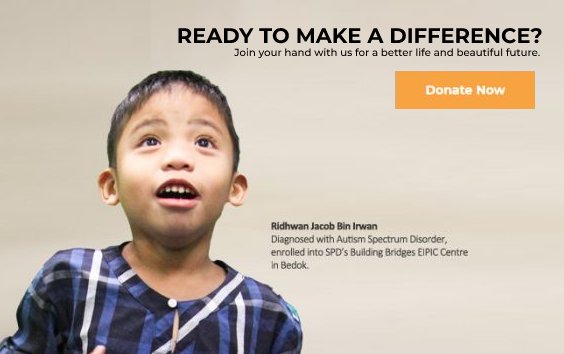Singapore, 22 April 2005 – 72-year-old Mr Chin Wan Fatt had his right leg amputated below the knee in September last year due to diabetes. Moving around became difficult and he is now looking forward to having a prosthesis made. This normally takes up to a month and would require several trips to the hospital for fitting and measurements, but with the ‘Direct Pressure Cast Prosthetic Socket for Transtibial Amputees’, he may get his artificial limb sooner than he thinks.
The brainchild of a group from NUS, this pressure casting technique is one of the winning ideas submitted to Singapore’s first assistive technology invention competition organized by The Society for the Physically Disabled’s (SPD) Specialised Assistive Technology Centre (ATC) in collaboration with A*STAR’s Institute for Infocomm Research (I2R). It produces a hydrostatic socket and facilitates the fabrication of a direct pressure cast socket made from braided carbon fibre. The technique allows for a prosthesis to be made in just two and a half hours.
AT is the application of technology to assist people with physical disabilities to overcome the limitation of their disabilities so as to enable them to perform their daily activities and be more independent. It includes devices that give mobility, enhance communication, provide computer access and allow for easier environmental control.
The Competition launched in September last year drew 26 entries in the student and open categories. Innovations that qualified for entry had to be a living, vocational or study aid or augmentative and alternative communication device that helps people with physical disabilities. Entries were judged on originality, impact, practicality, cost efficiency and inclusion of universal design features.
Said Prof Wong Lim Soon, I2R’s Deputy Executive Director (Research) and one of the judges for the Competition, “Our aim is to start some interest locally to develop and produce AT devices. On one hand, it gets people thinking of the needs of people with physical disabilities and creates greater awareness for them. On the other, it could spark thoughts in coming up with devices that help people with physical disabilities.”
SPD started providing services in Assistive Technology including assessment, consultation and training for people with physical disabilities in 2001. Today, the AT service is recognized as the Specialised ATC for all physically disabled people in Singapore.
The objective of the Specialised ATC is to enhance the rehabilitation of people with physical disabilities, equip disabled people with IT skills for work, advocate the use of AT for education and employment and encourage innovation and development of AT devices.
In its short history, the Centre has organized Singapore’s first AT Invention Competition. It has also successfully lobbied the Singapore Examination and Assessment Board to allow the use of AT for disabled students in mainstream school national examinations on a case-by-case basis. More recently, its collaboration with A*STAR, was awarded a research grant to work on the ‘brainy communicator’, a device which allows users to control the computer using only brain activity.
The Centre also conducts AT training for staff of Voluntary Welfare Organizations (VWOs), schools and other rehabilitation-related organizations, and engages in research and development. It works in partnership with the Infocomm Development Authority of Singapore, Ministry of Education, tertiary institutions and other VWOs to promote and encourage the use of AT.
To date, the Centre has helped more than 300 physically disabled persons in the use of AT, and provided IT training for over 500 persons. The Specialised ATC was officially opened by Minister of State for Community Development, Youth and Sports, Mrs Yu-Foo Yee Shoon this morning. The Centre is now co-funded by the government through the Voluntary Welfare Organisation Capability Fund (VCF) and corporate sponsors.
“Technology can level the playing field for the physically challenged. A disabled person can perform as well as a non-disabled person given the right assistive device. Through the Competition, we hope to develop a culture whereby the design and production of everyday products will factor in the needs of people with physical disabilities. This will move us towards being a more inclusive society,” said Ms Chia Woon Yee, Director of Technology at SPD. The Specialised ATC hopes to organize and conduct the AT Invention Competition biennially.
“We thought the competition was a great idea,” said Dr James Goh. His team won the top prize of $2,000 for coming up with the new pressure casting technique. “Being in the Orthopaedic Surgery and Bio Engineering Departments at NUS, we are always thinking up new ways that help to improve lives. This competition allows us to channel our creative energies to helping physically disabled people. It was both challenging and meaningful!”
The intellectual property rights of the inventions remain with the inventors. When asked what they plan to do with their invention, Dr Goh said, “We hope to interest the industry to take up the idea to develop it and market it commercially so that people will be able to benefit from it.”
The winning inventors received their prizes from Mrs Yu-Foo at the official opening of the Specialised Assistive Technology Centre. The event was followed by a three-day public forum and professional workshop on AT where participants will be given an overview of AT and shown how it can be applied at home, work and in school. The first time such a session is being organized, the Gain IT and Use IT Workshop will also offer training sessions in AT.
More information on the Specialised ATC, the projects under the Assistive Technology Invention Competition and the Gain IT and Use IT Workshop is available on the website spd.org.sg.

